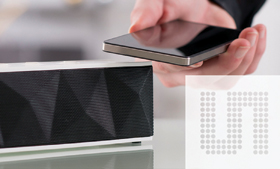

The new AS3955 from ams is an NFC interface chip (NFiC) with unique energy harvesting and data transfer capabilities.
Like its predecessor AS3953, the AS3955 provides a contactless bridge between a near-field communications (NFC) reader (for instance, a smartphone or tablet) and any microcontroller. But the AS3955 can also act as a power supply for the host device, harvesting as much as 5 mA at 4,5 V – enough to charge a Li-ion cell battery – from the RF energy radiated by an NFC reader.
This harvested energy can also be used to power external circuitry, enabling the implementation of standalone, eco-friendly, batteryless product designs such as wireless sensor interfaces, interactive games and toys, smart price tags in shops and smart payment cards.
The device also offers the designer a choice of two bidirectional data transfer modes: Extended mode allows the use of standard NFC tag commands to transfer data with minimum processing overhead on the host microcontroller; Tunnelling mode provides a transparent and fully flexible channel between the reader and the host microcontroller, leaving the user free to implement any standard or proprietary communication protocol. Neither mode requires data buffering in the internal EEPROM memory, resulting in faster data transfers.
The AS3955 features a high-performance RF front end, which connects to a simple external NFC antenna without additional external components required. It also includes an EEPROM memory (of 2 Kb or 4 Kb) and an SPI or I²C interface for communication with an external microcontroller.
A unique data management feature is the new Stealth mode; this enables the host MCU to deactivate the NFiC’s RF channel via the I²C or SPI interface after an operation such as Bluetooth pairing has been completed successfully. This provides for guaranteed user control of NFC operation. The AS3955 also offers 32-bit password protection of its EEPROM memory.
Furthermore, Silent mode allows for fail-safe Bluetooth pairing. If the host’s battery has insufficient remaining charge to power its Bluetooth module, the AS3955 automatically disables its RF circuitry to prevent the device from initiating a pairing procedure.
These energy and data management features find a wide range of uses in industrial, consumer and gaming equipment. Products can be configured or personalised, for instance at the end of a factory’s production line, without the need to be powered. The high transfer speed and energy harvesting capability reduces the time taken to download configuration data, helping to increase throughput in high-volume manufacturing lines.
The device is fully compliant with the ISO 14443A standard up to level 4, and with NFC Forum specifications, supporting both Type 2 Tag standalone functionality and Type 4 Tag emulation in combination with an external MCU. It is available in a 10-pin, 3 x 3 mm MLPD package, with wafer-level chip scale packages (WL-CSP) and sawn wafers available on request.
For more information contact NuVision Electronics, +27 (0)11 608 0144, [email protected], www.nuvisionelec.co.za
| Tel: | +27 11 608 0144 |
| Email: | [email protected] |
| www: | www.nuvisionelec.com |
| Articles: | More information and articles about NuVision Electronics |

© Technews Publishing (Pty) Ltd | All Rights Reserved